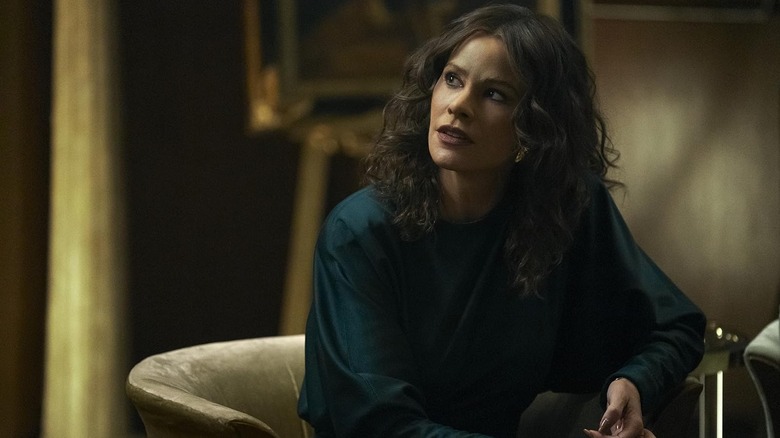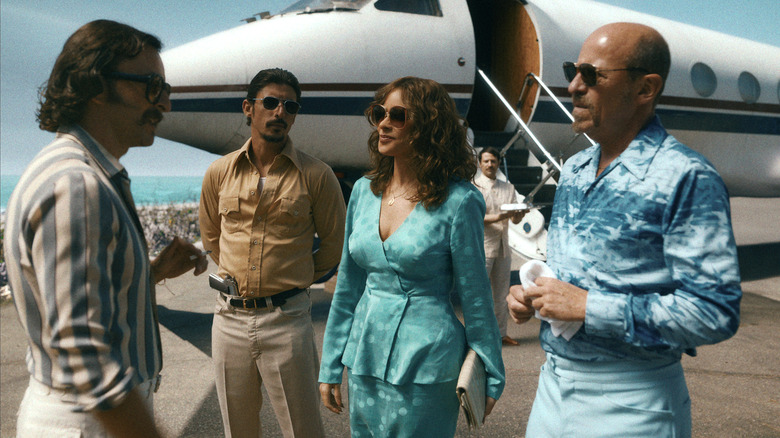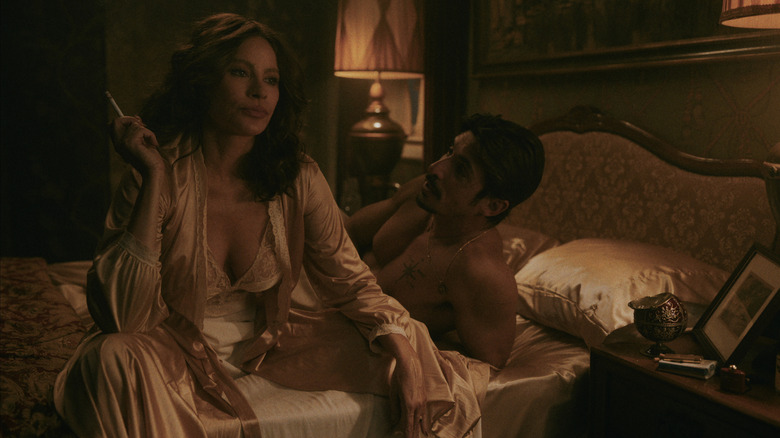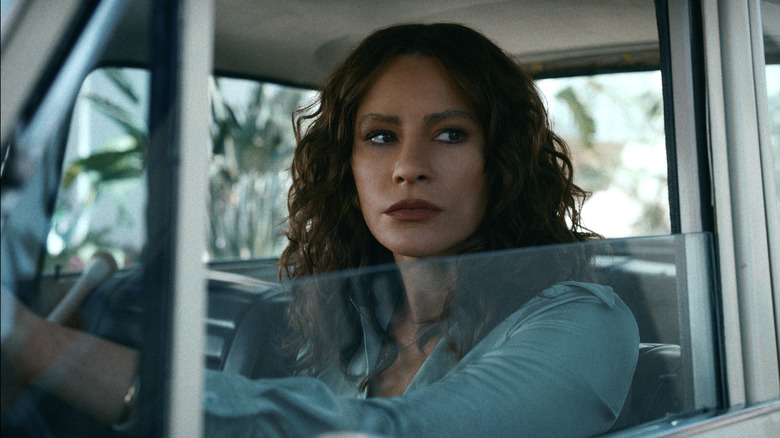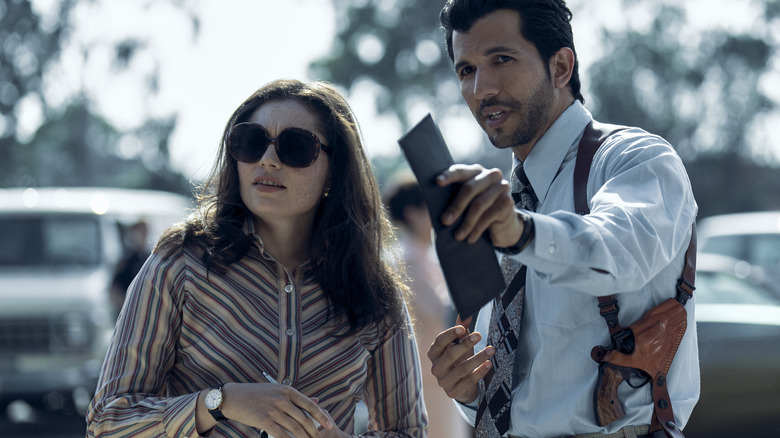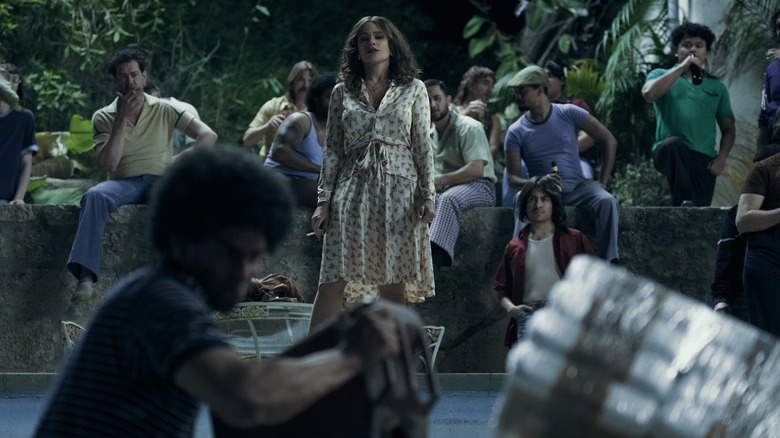This Is The True Story Behind Netflix's Griselda Series
Almost everyone knows the name of Tony Montana, the fictional drug lord immortalized by Al Pacino in the 1983 movie "Scarface," yet few know the name of Miami's real-life most notorious king, er, queenpin, Griselda Blanco Restrepo. In the late 1970s, Blanco seized control of Miami's drug trade through incredible violence, waging war on any who opposed her. This led to the "Cocaine Cowboy" wars, in which Blanco's enforcers would kill their opponents in broad daylight, sometimes in motorcycle drive-by shootings. Blanco's life story is both fascinating and terrible, full of sex, drugs, and murder, and is totally ripe for a fictionalized interpretation.
Sofia Vergara stars as Blanco in "Griselda," a six-part limited series on Netflix that tells the story of the infamous self-made billionaire, drug pusher, and multiple murderer, although the real story is even more brutal and impossible to believe than the miniseries depicts. "Griselda" was made by "Narcos" creators Eric Newman and Andrés Baiz and it's as salacious as one might expect, but in some instances, the truth really is even wilder than fiction. Let's take a look at the story behind the real Griselda Blanco, who rose from nothing on the streets of Colombia by being absolutely ruthless.
Seemingly fearless from a young age
Throughout her reign as the queen of cocaine in Miami, Blanco seemed to be fearless, but that was developed by necessity at an early age. Blanco had a difficult childhood, growing up in poverty in Medellín, Colombia, during an intense period of violence and unrest known as La Violencia. She allegedly began her life of crime at the tender age of 11, kidnapping a local boy and holding him for ransom, then murdering him when the ransom wasn't paid. She ended up marrying into crime, too, meeting her first husband, Carlos Trujillo (who made his living creating false documents and trafficking humans), when she was a 13-year-old sex worker. It seems like Blanco would do whatever was necessary to survive, and she learned early on that the only way to do so was to kill before being killed.
Blanco and Trujillo had three children together but divorced by the late 1960s due to business disagreements impeding their marriage. Trujillo died in the mid-1970s, a few years after the divorce, and while some claim that he died of natural causes, many believe that Blanco had him killed. This would become a theme in her life, as she came to be known as the "Black Widow" when her paramours had their lives cut short.
The bold and bloodthirsty Black Widow
For the most part, Blanco had assassinations carried out by other people, ordering murders left and right, but there were some she carried out personally. One such murder was that of her second husband, Alberto Bravo (Alberto Ammann), during a dispute over missing money. Blanco and Bravo created a lucrative drug smuggling organization, running cocaine from Colombia to New York City, but while in Colombia in 1975, they got into an argument that ended with Bravo dead and Blanco shot in the stomach.
Blanco's third husband would meet a similar fate, cementing her legacy as a black widow whose lovers didn't last long. She married assassin Dario Sepulveda (Alberto Guerra) in 1978 and the two had a son together. She named him Michael Corleone after Al Pacino's character in "The Godfather," showing just how much she embraced her criminal legacy. In 1983, Sepulveda took Michael Corleone and returned to Colombia, where Blanco allegedly had him killed — shot dead in his vehicle while his son sat in the passenger seat. Michael Corleone has protested Netflix's creation and release of the series, suing Netflix and saying he wasn't consulted and should have been. He is Blanco's only surviving son and has been interviewed about her for documentaries, including National Geographic's "Narco Wars."
A talent for cruelty
While some readers might want to shout "yas queen" at the idea of a powerful female gangster who knocks off her husbands, Blanco's legacy of cruelty is too much to ignore. Shaped by violence in her childhood that was honed into a fine point by years of hardcore cocaine usage, Blanco could be an absolute terror. At the height of her $1.5 billion empire, she allegedly behaved with impunity, ordering assassinations in broad daylight and orchestrating wild acts of sex and violence. Addicted to a form of cocaine called basuco, she would host orgies, force people to have sex at gunpoint, and even allegedly had eight strippers killed because she thought they had sex with Sepulveda. She also had a German Shepherd named Hitler. (Yes, really.)
One of Blanco's greatest claims to fame is that she said she originated the idea of motorcycle drive-by shootings, allowing her assassins to conduct hits all over Miami and then speedily escape. Sometimes her drive-bys didn't go as planned, like when one of her assassins accidentally killed the target's two-year-old son instead of the target. Since Blanco had wanted the man killed because she thought he kicked one of her sons, she felt the death of his son was justice and considered the accident a blessing. She was as bloodthirsty as they come and reveled in violence. Colombian officials tie her to around 250 murders, while U.S. officials believe she is responsible for at least 40. That's a lot of blood on her hands.
Bringing down Blanco
When you're that open about doing drugs and killing people, you're eventually going to get caught. For Blanco, that didn't come until 1985, when she was finally arrested by the Drug Enforcement Agency (DEA). By then she had already run away to California, trying to dodge Miami law enforcement, but it didn't work out too well. Blanco was convicted and sentenced to 15 years in prison for her 1975 drug trafficking indictment, and then nearly a decade later she was charged with three murders. In 1998, she pled guilty to the murder charges but only served six years of her 60-year sentence in a U.S. prison before being deported to Colombia.
The person responsible for tying all of Blanco's various crimes to her was Miami-Dade detective June Hawkins (Juliana Aidén Martinez), one of the first female homicide detectives in Miami. Though she had to endure a great deal of harassment at the hands of her male coworkers, she managed to figure out that Blanco was the source of all of the violence, helping other law enforcement agencies build their case against her. Her partner in solving crime was Al Singleton (Carter MacIntyre), and though the two were married to other people at the time and never got involved while they were working together, the duo ended up getting together romantically and got married in 2004.
The last days and legacy of La Madrina
Griselda Blanco Restrepo met her end on September 3, 2012, gunned down at an open-air butcher shop in Medellín. She was 69 years old. Her assassins sought to send a message, as she was shot twice in the head by a gunman on the back of a motorcycle — the very method of assassination she claimed to originate. She was survived only by Michael Corleone Blanco, who was under house arrest in Miami at the time for his own drug trafficking charges.
Though she may be gone, Blanco's legacy lives on, for better and worse. Immortalized in documentaries like "Cocaine Cowboys" and fictionalized accounts like "Griselda," there's a tendency to romanticize and even glorify her reign of terror, much like they do to fellow Colombian drug lord Pablo Escobar. Escobar and Blanco were aware of one another, as Escobar said of Blanco:
"The only man I was ever afraid of was a woman named Griselda Blanco."
Coming from someone who was potentially responsible for more than 4,000 murders, that's pretty terrifying. Perhaps no fictional account could ever truly do the story of Griselda Blanco justice. Her brutality is too much to be believed.
